 The Seagate Enterprise Turbo SSHD is a 2.5" 15K SAS HDD coupled with 32GB of eMLC flash that focuses on exceptional dollar-to-IOPS performance and capacity. With an estimated performance increase of 300% over a 15,000 RPM HDD, the Enterprise Turbo SSHD specializes in business-critical transactional environments (OLTP, VDI, SAP HANA), while also being considerably more cost-effective than a comparable SSD solution. The advantages of a marriage between HDD and SSD is made clear with the Enterprise Turbo SSHD: the performance and speed increases one would expect from an SSD, with a price point and capacity of an HDD.
The Seagate Enterprise Turbo SSHD is a 2.5" 15K SAS HDD coupled with 32GB of eMLC flash that focuses on exceptional dollar-to-IOPS performance and capacity. With an estimated performance increase of 300% over a 15,000 RPM HDD, the Enterprise Turbo SSHD specializes in business-critical transactional environments (OLTP, VDI, SAP HANA), while also being considerably more cost-effective than a comparable SSD solution. The advantages of a marriage between HDD and SSD is made clear with the Enterprise Turbo SSHD: the performance and speed increases one would expect from an SSD, with a price point and capacity of an HDD.
The Seagate Enterprise Turbo SSHD is a 2.5" 15K SAS HDD coupled with 32GB of eMLC flash that focuses on exceptional dollar-to-IOPS performance and capacity. With an estimated performance increase of 300% over a 15,000 RPM HDD, the Enterprise Turbo SSHD specializes in business-critical transactional environments (OLTP, VDI, SAP HANA), while also being considerably more cost-effective than a comparable SSD solution. The advantages of a marriage between HDD and SSD is made clear with the Enterprise Turbo SSHD: the performance and speed increases one would expect from an SSD, with a price point and capacity of an HDD.
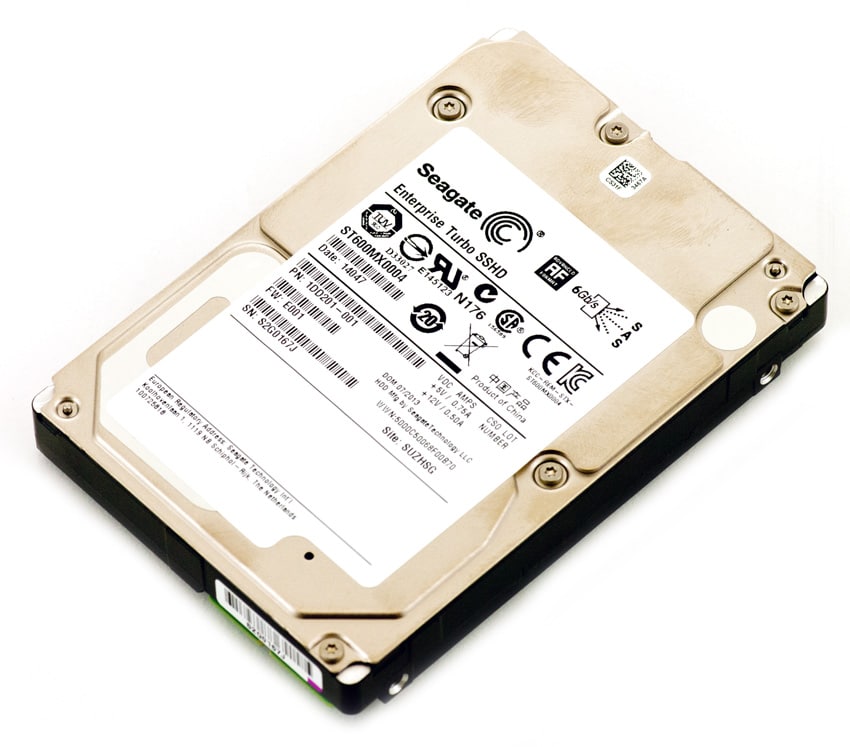
The real motivator behind the increased performance of the Seagate Enterprise Turbo SSHD is its NAND caching. With 32GB of eMLC read cache, the Enterprise Turbo is able to hold "hot" data in the NAND for faster delivery that would otherwise be possible from the platters. Seagate also means to address performance bottlenecks by conducting its caching at the I/O level, while its AMT algorithm ensures that hot data is intelligently and correctly identified for caching. An additional 8MB of NVC (non-volatile cache) backed write-cache helps to further improve performance and is protected against unanticipated power loss. In the event of such power loss, the drive uses energy from the spindle motor to flush pending writes to NV memory. Seagate assures that the wear-and-tear on the NAND in this case will be negligible, as power failure in an enterprise setting is highly uncommon.
Integrating Seagate Enterprise Turbos into existing infrastructure is simply a matter of installing the drives; no additional drivers, software or is configuration required. The ease of deployment is also matched by an impressive array of security features. The Turbo drives are available without encryption, with encryption or with FIPS. The drives are also paired with a five year warranty.
Seagate clearly has a hold on the technology for hybrid drives, or solid state hybrid drives as Seagate prefers. Understanding how these fit into the enterprise storage market at large is important to understanding the overall value proposition of Turbo. Seagate already sells 10K and 15K standard hard drives. This market, however, is under heavy assault by SSDs, especially in the case of 15K hard drives, where SSDs can offer massive improvements in performance, operating expense and capacity. In fact, large array vendors are targeting the high speed spindle tier specifically, replacing those drives with flash and achieving the same performance levels for all of the benefits just listed. Dell Compellent is perhaps one of the most vocal in this arena, but others are following suit.
This doesn't mean that the 10k/15K tier of hard drives is immediately gone however, as there are still many reasons to keep them in production. In the vast majority of enterprise use cases these drives provide sufficient performance, with a price per GB cost that's favorable when compared to flash, and there are no questions about drive endurance. The value prop for 10K remains a little stronger given the innovations in performance and density there, the Savvio 10K.7 for instance bested the prior generation by 33% in capacity an provides a great blend of throughput and latency in a 1.2TB capacity. The arguments in favor of the 15k get a little harder to make though, with limited capacity, cost premium and less investment in innovation on those platforms across the industry.
There is yet another consideration though when thinking about the place of flash and HDDs in the datacenter and that's caching solutions. Beyond array vendors who offer an integrated tiering or caching solution, there are seemingly an endless supply of in-host or distributed server-side caching solutions that leverage some form of software and flash in front of a traditional platter-based array. The trick here though, is that almost all of these solutions are read cache only and the ones that do write caching do so in ways that can be unconventional to say the least. There's also a requirement to figure out licensing, installation of software/hardware and the infusion of flash to some degree or another inside every compute node/server.

This overview of high-performance storage considerations helps to frame where the Enterprise Turbo fits into place in the storage market. Turbo takes a known platform, Seagate's 15K 600GB drive, and attaches endurance-optimized eMLC NAND to deliver an integrated solution for read caching. The integrated piece is key, just drop the drives into any system that support them and that system now delivers much greater performance. For anyone who follows us on Twitter, you know from our early looks that this means gains more than 2X in some cases. That's pretty impressive given such a small NAND allocation. Of course that's just the tease, detailed results and comparisons to Seagate's mainstream 10K hard drives follow below.
The Turbo ships in 300GB, 450GB and 600GB capacities. Our review units comprise sixteen of the 600GB capacity. OEM samples of Enterprise Turbo are shipping now and volume production will begin mid-2014.
Enterprise Turbo SSHD Specs
- Capacities
- 600GB (ST600MX0004)
- 450GB (ST450MX0004)
- 300GB (ST300MX0004)
- Form factor: 2.5", 15mm
- Interface: SAS 6Gb/s
- Encryption: None, Standard Encryption or FIPS
- SSD Cache: 32GB eMLC read cache, 8MB of NVC-backed write cache
- Buffer: 128MB DRAM
- RPM: 15,000K
- IOPS: Up to 900
- MTBF/AFR: 2 million, .44%
- Warranty: 5 years
Design and Build
On the surface the Seagate Turbo SSHD looks like any other standard enterprise hard drive. Of course it has much more to offer, with the 32GB of NAND cache tucked away on the PCB. The Turbo follows the traditional 2.5" 15-mm z-height form-factor, making it compatible with any systems designed to use enterprise HDDs.
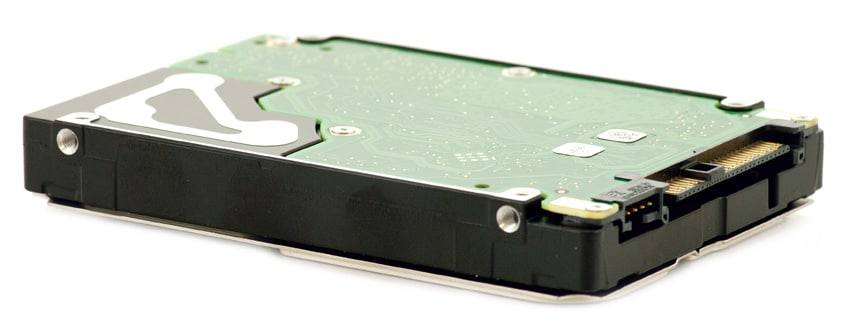
Inside the Seagate Turbo SSHD, the primary controller is a Marvell-chipset with the large 32GB Samsung eMLC NAND package visible.
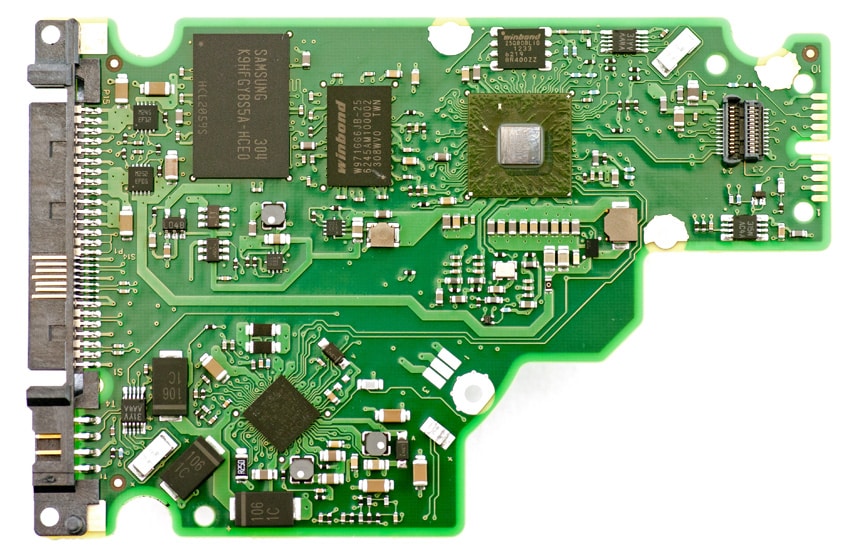
Testing Background and Comparables
SAS Enterprise HDD comparables for this review:
- HGST Ultrastar C10K900 900GB
- Seagate Savvio 10K.6 900GB
- Seagate Savvio 10K.7 1.2TB
- Toshiba MBF2600RC 600GB
- Toshiba MK01GRRB 147GB
All enterprise HDDs are benchmarked on the same testing platform for each test.
For our Synthetic FIO tests, we use our ThinkServer RD240 configured with:
- 2 x Intel Xeon X5650 (2.66GHz, 12MB Cache)
- Windows Server 2008 Standard Edition R2 SP1 64-Bit and CentOS 6.2 64-Bit
- Intel 5500+ ICH10R Chipset
- Memory – 8GB (2 x 4GB) 1333Mhz DDR3 Registered RDIMMs
- LSI 9211 SAS/SATA 6.0Gb/s HBA

Application tests each have a unique environment that is detailed on each benchmark page. For cases where 16 drives are tested, an iXsystems Titan 316J JBOD was added to the environment and connected to the relevant cluster via external SAS cable.
Application Performance Analysis
In the enterprise market, there is a huge difference between how products claim to perform on paper and how they perform in a live production environment. We understand the importance of evaluating storage as a component of larger systems, most importantly how responsive storage is when interacting with key enterprise applications. To this end, we've rolled out application tests including our proprietary MarkLogic NoSQL Database Storage Benchmark, MySQL performance via SysBench, SQL Server performance via Benchmark Factory as well as VMmark virtualization performance by VMware.
In the MarkLogic NoSQL Database environment, we test fast storage solutions with a usable capacity greater than or equal to 700GB. Our NoSQL database requires roughly 650GB of free space to work with, evenly divided between four database nodes. In our testing environment, we use an SCST host and present each device in JBOD, with one device or partition allocated per database node. The test repeats itself over 24 intervals, requiring between 36-48 hours total for the drives in this category. Measuring the internal latencies seen by the MarkLogic software, we record both total average latency, as well as interval latency for each drive.
Comparing the overall average latency between the Seagate Turbo SSHD in RAID10 against two traditional 10K and 15K SAS HDDs, the Turbo was able to offer a huge boost in performance. If a buyer chose to use a traditional 15K SAS drive in this particular scenario, latency would jump by 64%; if they stuck with 10K SAS, latency would be 148% higher. Looking at our overall rankings for all devices tested in our MarkLogic NoSQL benchmark, the Seagate Turbo SSHD also beats out some SSD-only comparables.
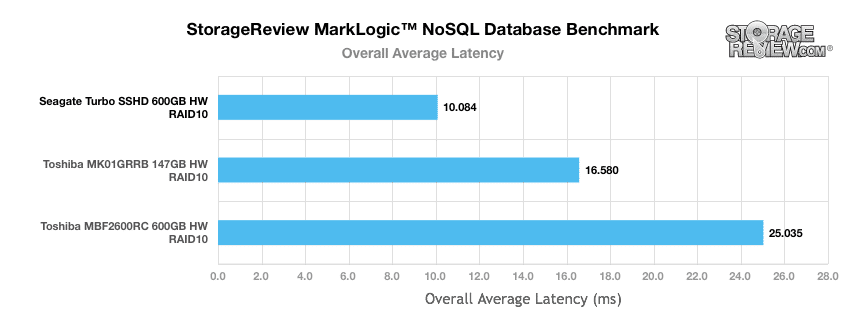
Looking at the detailed latency view of the Seagate Turbo SSHD in our NoSQL benchmark, the hybrid drives were able to keep a tight and consistent spread even as the test pressed on over two days.
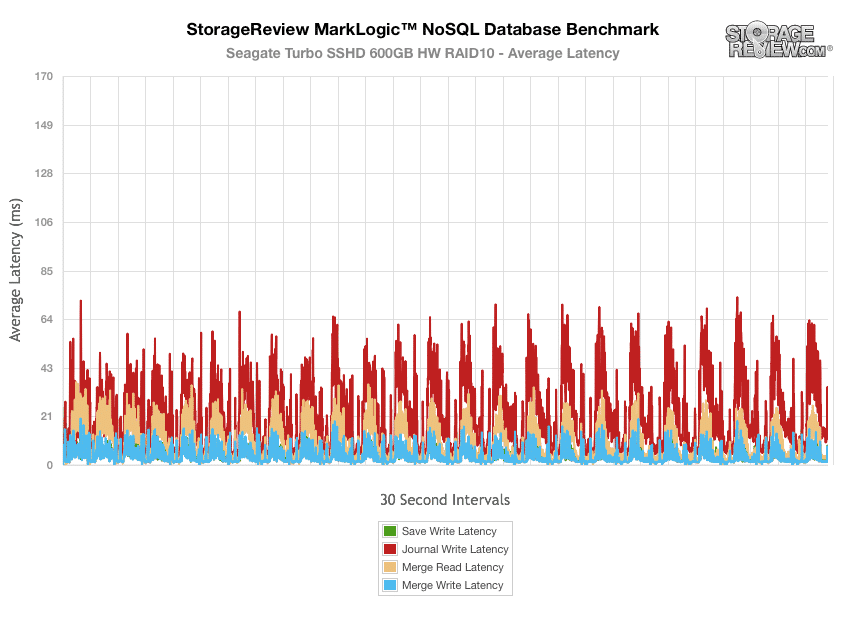
Moving down to a traditional 15K SAS drive in RAID10, the latency view picked up substantially over each interval of the test.
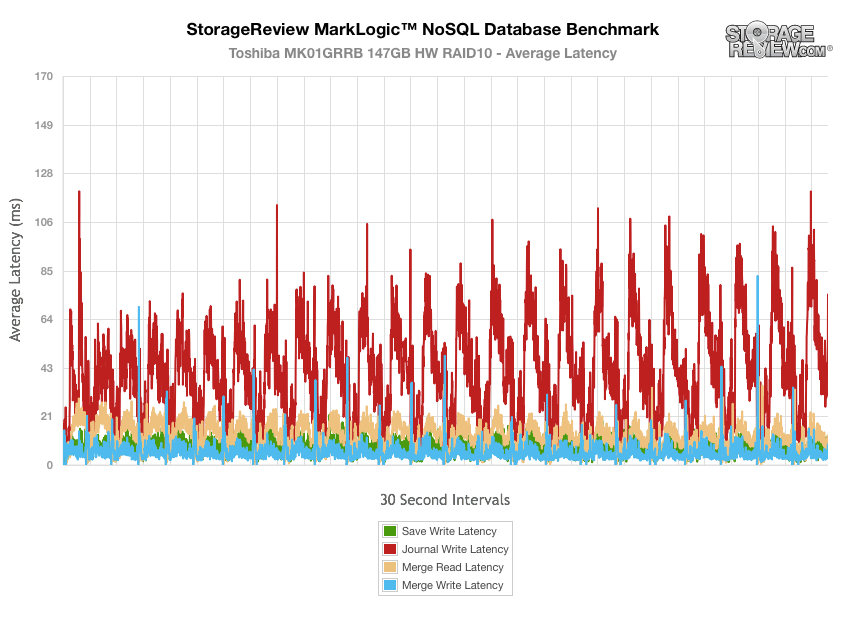
With traditional 10K SAS drives in RAID10, the overall latency picture gets even worse as times get more than double.
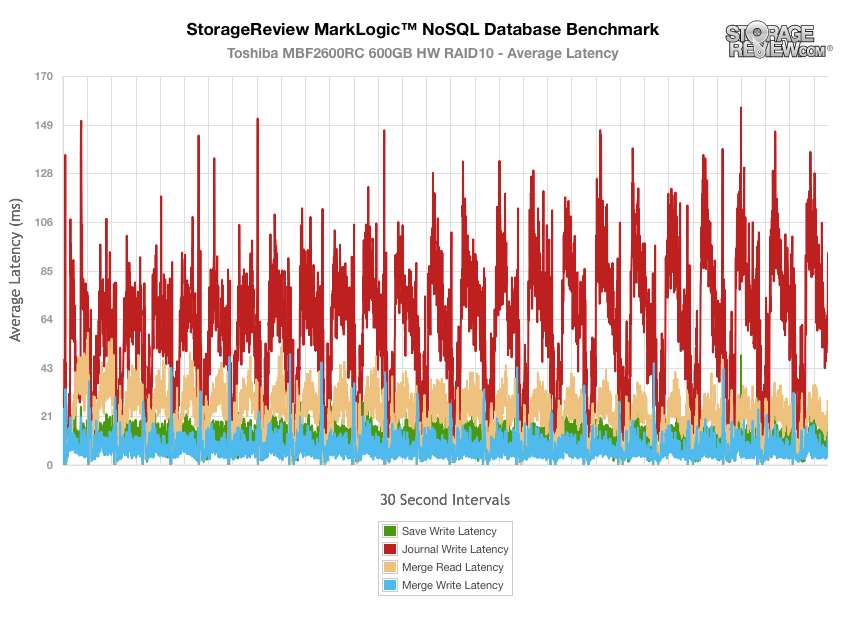
Our next application test consists of Percona MySQL database test via SysBench, which measures the performance of OLTP activity. In this testing configuration, we use a group of Lenovo ThinkServer RD630s and load a database environment onto a single SATA, SAS or PCIe drive or a group of HDDs using an LSI 9286-8e RAID card. This test measures average TPS (Transactions Per Second), average latency, as well as average 99th percentile latency over a range of 2 to 32 threads. Percona and MariaDB are using the Fusion-io flash-aware application APIs in the most recent releases of their databases, although for the purposes of this comparison we test each device in their "legacy" block-storage modes.
With a working database footprint of about 260GB, we looked at the performance in both RAID10 as well as RAID00 using the Seagate Turbo SSHD. While we'd never recommend RAID00 for a production environment, its use was chose to show what RAID10 performance might be with a larger disk group of 32 drives. With 32GB of eMLC per disk, it worked out to roughly 256GB usable in our RAID10 configuration and 512GB usable in our RAID00 configuration. Compared to the Seagate Savvio 10K.7 1.2TB 10K SAS HDD, the Seagate Turbo SSHD was able to offer significantly higher throughput, peaking at 1,267TPS in RAID00 or 959TPS in RAID10, compared to the 10K SAS that topped at 401TPS.
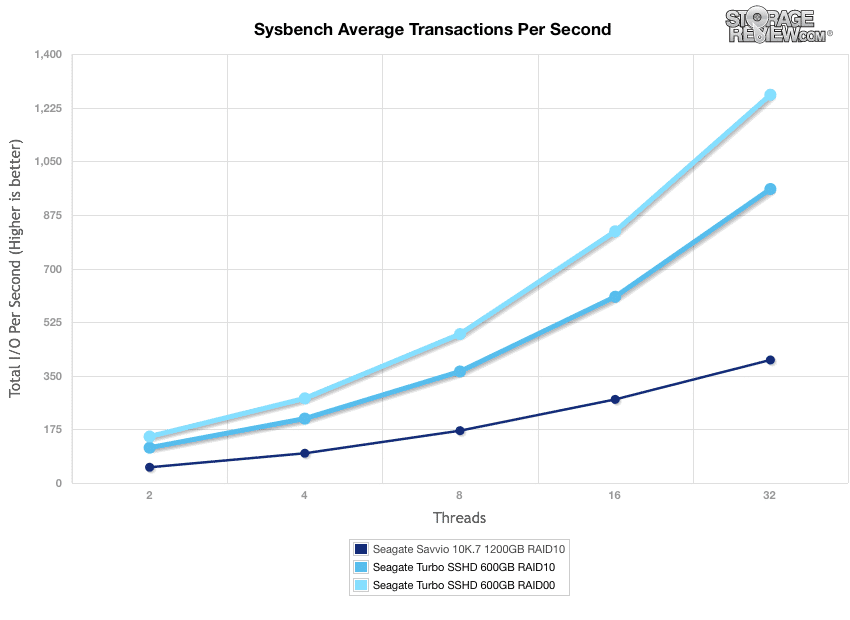
Measuring average latency in our Sysbench MySQL test, the Seagate Turbo SSHD scaled from 17.36ms at 2-threads to 33.35ms in RAID10, while RAID00 scaled from 13.19ms to 25.25ms.
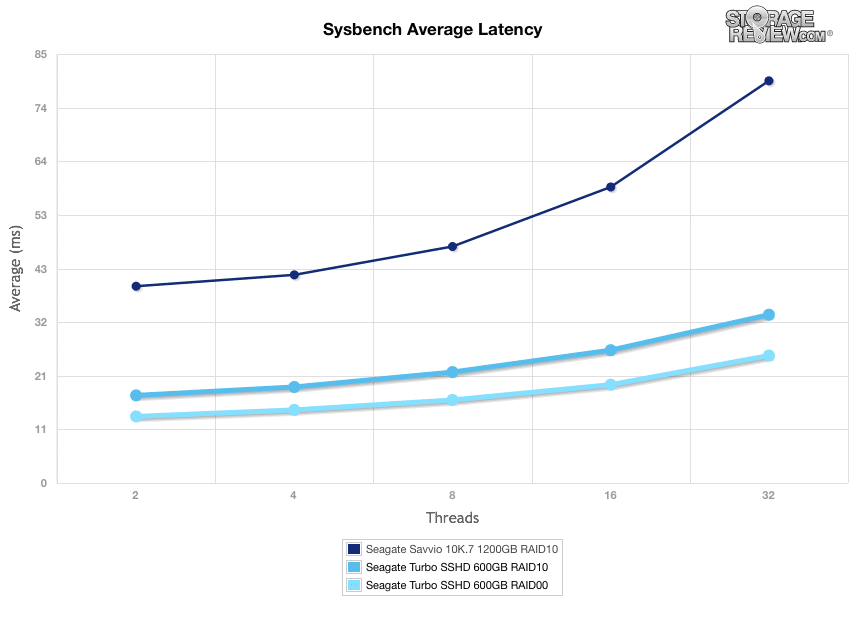
Comparing the 99th percentile latency in during the TPC-C Sysbench test, the Seagate Turbo SSHD was able to keep things much more calm than the traditional 10K SAS array.
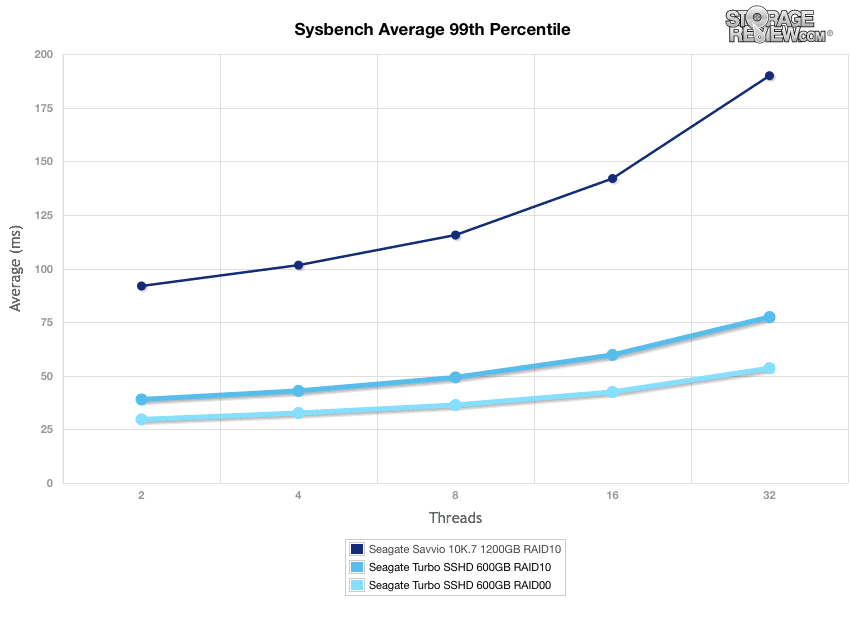
Our next database test covers performance in Microsoft's SQL Server environment that leverages a 685GB (3,000 scale) SQL Server database and measures the transactional performance and latency with a 30,000 VU Load. We also include results from a smaller 333GB (1,500 scale) SQL Server database to better size the cache to the workload.
Looking at the transactional performance of each drive configuration, the progression in performance between the Savvio 10k.7 and the Turbo SSHD is just 14% higher, although as we'll see below looking at latency that difference is much greater.
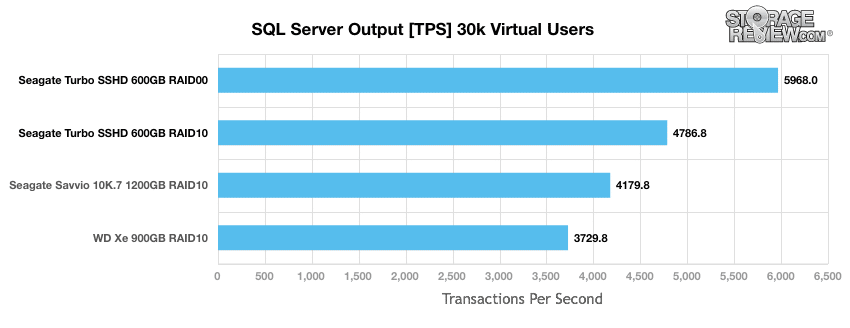
Comparing average latency between each storage configuration, the Seagate Turbo SSHD in RAID10 offered a modest boost in TPS as seen above, although the latency drop was much more dramatic. Average latency dropped 37% compared to the 10K SAS drive, and if you focused on the RAID00 configuration, latency dropped by a staggering 88%.
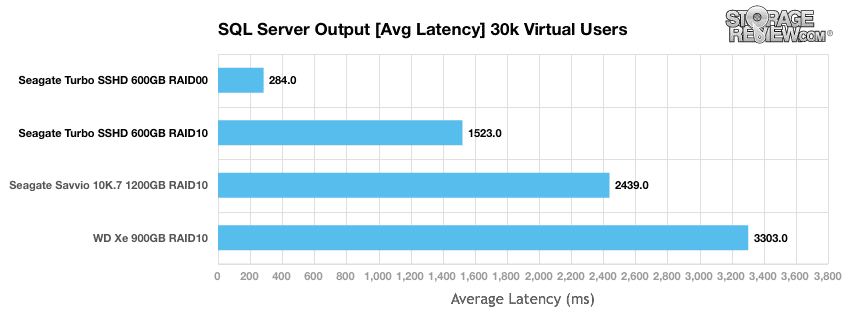
Moving to a smaller database size that better fits the NAND cache amount in our RAID10 configuration of the Turbo SSHD, we see the TPS difference between the Turbo RAID00 and RAID10, and Savvio 10K.7 RAID10 isn't that huge, although again most of the difference behind the scenes is on the latency aspect.
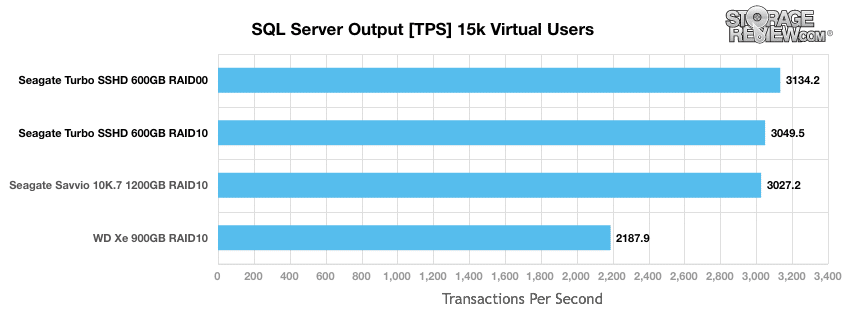
Comparing average latency in our SQL Server TPC-C benchmark with a load of 15,000 VU, the Seagate Turbo SSHD offered an improvement of 17% compared to the 10K.7 RAID10 storage pool or 80% when configured in RAID00.
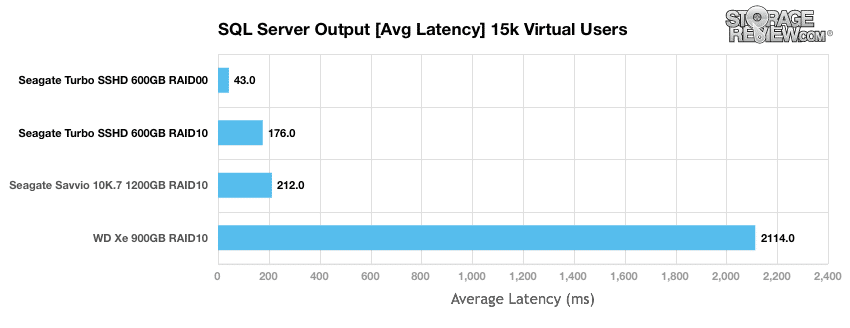
Our VMmark protocol utilizes an array of sub-tests based on common virtualization workloads and administrative tasks with results measured using a tile-based unit that corresponds to the ability of the system to perform a variety of virtual workloads such as cloning and deploying of VMs, automatic VM load balancing across a datacenter, VM live migration (vMotion) and dynamic datastore relocation (storage vMotion).
For both the VMmark benchmark, we will compare the performance of the Seagate Turbo SSHD to the Seagate Savvio 10K.7 1.2TB HDD, both configured in a RAID10 storage pool and presented as network storage through a Windows Server 2012 R2 storage host. For the RAID card, we leveraged Adaptec's new Series 8 8160ZQ, installed in our Lenovo ThinkServer RD630.
Comparing the normalized VMmark 2.5.1 performance, the Seagate Turbo SSHDs were able to extend up to a load of 4-tiles, whereas the Seagate Savvio 10K.7's topped out at 2-tiles. For the loads they both ran, the Turbos had an edge in performance from tighter QoS latency during runs.
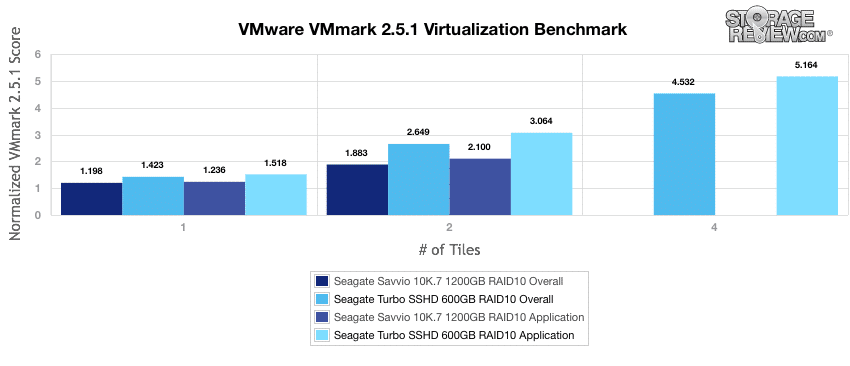
Enterprise Synthetic Workload Analysis
Flash and cached performance varies throughout the preconditioning phase of each storage device. Our enterprise storage benchmark process begins with an analysis of the way the drive performs during a thorough preconditioning phase. Each of the comparable drives are preconditioned into steady-state with the same workload the device will be tested with under a heavy load of 16 threads with an outstanding queue of 16 per thread, and then tested in set intervals in multiple thread/queue depth profiles to show performance under light and heavy usage.
Preconditioning and Primary Steady-State Tests:
- Throughput (Read+Write IOPS Aggregate)
- Average Latency (Read+Write Latency Averaged Together)
- Max Latency (Peak Read or Write Latency)
- Latency Standard Deviation (Read+Write Standard Deviation Averaged Together)
Our condensed Enterprise Synthetic Workload Analysis includes one profiles designed to show peak random I/O from each device. This profile is designed to be used as a baseline comparable to cross-reference manufacturer claims of random transfer speeds.
- 4k
- 100% Read or 100% Write
- 100% 4k
In our 100% 4K random read and write test, measuring the performance across the full LBA spectrum of the Seagate Turbo SSHD (showing its baseline 15K speeds) we measured 593 IOPS read and 457 IOPS write. That compared to 442 IOPS read and 363 IOPS write from its higher-capacity and slower-spindle brother, the Savvio 10K.7.
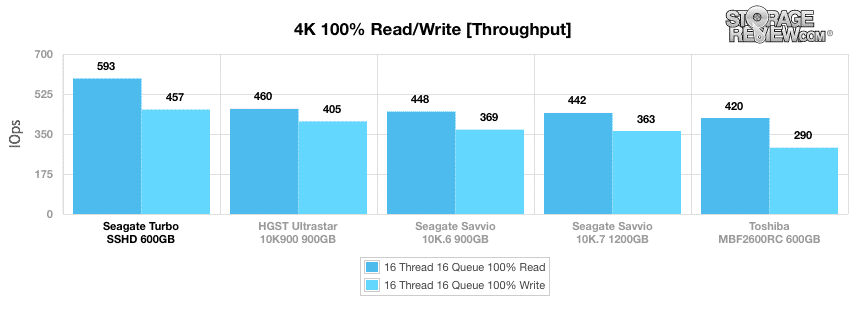
With its quickest spindle speed in the group, the Seagate Turbo SSHD offered the lowest average latency in our heavy 16T/16Q workload, measuring 431ms read and 590ms write.
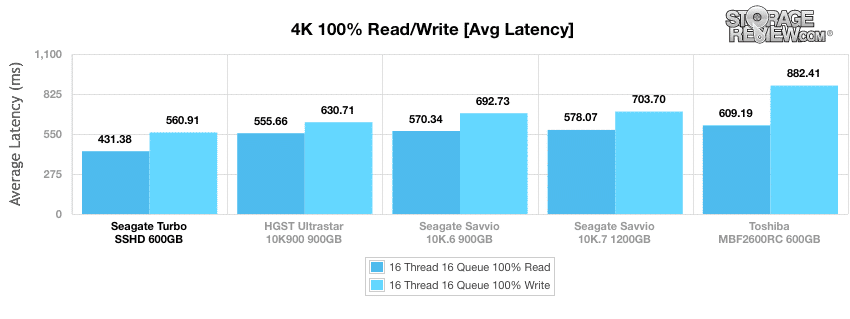
While the Seagate Turbo SSHD offered the higher throughput and lowest average latency, its peak latency was towards the upper middle of the pack on read, and at the bottom of the pack on write.
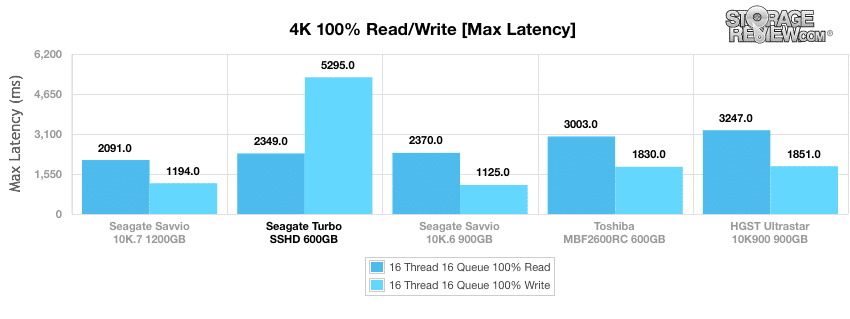
Similar to its peak latency figures in the random 4K test, the standard deviation from the Seagate Turbo SSHD ranked towards the front of the pack in read activity, but lagged with write activity.
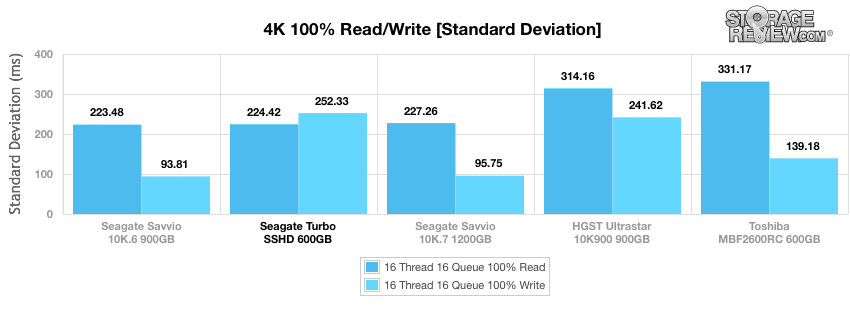
Conclusion
Seagate makes a bold claim with the Enterprise Turbo SSHD, "The World’s Fastest Hard Drive." Normally, storage companies like to use a bit of bravado as part of their marketing claims, but saying "World's Fastest" is pretty strong. Here's the thing though, they're right. The Turbo is absolutely smoking and the results trounced Seagate's own 10K SAS drives, which posted over 200% gains in some cases. For enterprises looking to refresh an array but don't have the budget or IOPS/latency need for an all flash solution, the Turbo is the superior choice.
Diving deeper into performance, we saw huge gains in all of our enterprise application workloads. In our MarkLogic NoSQL database benchmark the Seagate Turbo SSHD offered huge gains compared to 10K and 15K SAS HDDs and even surpassed some of the SSDs we've tested to date. We saw strong improvements as well under TPC-C workloads in both our CentOS MySQL and Windows Server 2012 SQL Server environments. Last but not least our VMware VMmark 2.5.1 benchmark saw double the performance over traditional 10K SAS HDDs. Across the board we didn't encounter one application environment that didn't benefit from the Seagate Turbo SSHD.
It's pretty hard to find anything to complain about with the Turbo. The drive offers plug and play compatibility, various encryption models and comes with a five year warranty and 2 million hour MTBF. The top side capacity of 600GB is about the only issue, but that's because it's on a 15K RPM platform, which is nice for when the data ultimately needs to go to disk. It's not unreasonable, however, to presume that Seagate will soon bring the tech to 10K enterprise drives, perhaps bumping the cache size to compensate for the doubled capacity Seagate 10K drives offer. Of course the 10K hybrids already exist today, Seagate makes the IBM 600 GB 10,000 rpm 6Gbps SAS 2.5-inch Hybrid. While a 10K hybrid cannibalizes the 15K versions, long term the 10K platform makes the best sense from a cost/capacity per dollar perspective.
Pros
- Leading application performance across the board
- Plug and play performance boost, no software needed
- Unexpected power fail data protection
Cons
- Capacity limited to 600GB in current iteration
- SSD prices continue to fall putting pressure on Turbo pricing
Bottom Line
Seagate accurately describes the Enterprise Turbo SSHD as the world's fastest hard drive. Turbo is over 2X faster than 10K HDDs in workloads that matter, such as virtualization and OLTP. For any enterprise who wants the best disk can offer, the Enterprise Turbo is the answer.
Seagate Enterprise Turbo SSHD Product Page
